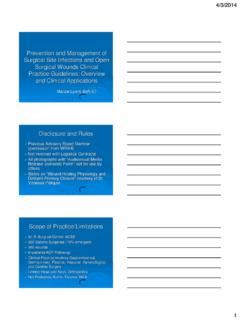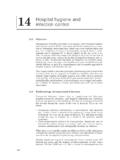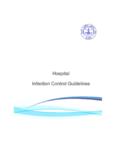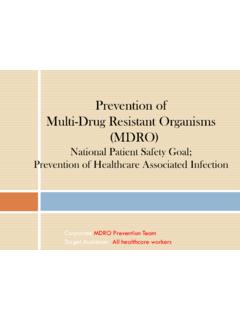Transcription of Prevention of hospital-acquired infections
1 WHO/CDS/CSR/ Prevention of hospital - acquired infections A practical guide 2nd edition World Health Organization Department of Communicable Disease, Surveillance and Response This document has been downloaded from the WHO/CSR Web site. The original cover pages and lists of participants are not included. See for more information. World Health Organization This document is not a formal publication of the World Health Organization (WHO), and all rights are reserved by the Organization. The document may, however, be freely reviewed, abstracted, reproduced and translated, in part or in whole, but not for sale nor for use in conjunction with commercial purposes.
2 The views expressed in documents by named authors are solely the responsibility of those authors. The mention of specific companies or specific manufacturers' products does no imply that they are endorsed or recommended by the World Health Organization in preference to others of a similar nature that are not mentioned. WHO/CDS/CSR/ DISTR: GENERAL. ORIGINAL: ENGLISH. Prevention of hospital - acquired infections A PRACTICAL GUIDE. 2nd edition Editors G. Ducel, Fondation Hygie, Geneva, Switzerland J. Fabry, Universit Claude-Bernard, Lyon, France L. Nicolle, University of Manitoba, Winnipeg, Canada Contributors R.
3 Girard, Centre Hospitalier Lyon-Sud, Lyon, France M. Perraud, H pital Edouard Herriot, Lyon, France A. Pr ss, World Health Organization, Geneva, Switzerland A. Savey, Centre Hospitalier Lyon-Sud, Lyon, France E. Tikhomirov, World Health Organization, Geneva, Switzerland M. Thuriaux, World Health Organization, Geneva, Switzerland P. Vanhems, Universit Claude Bernard, Lyon, France WORLD HEALTH. ORGANIZATION. Acknowledgements The World Health Organization (WHO) wishes to acknowledge the significant support for this work from the United States Agency for International Development (USAID). This document was developed following informal meetings of the editorial working group in Lyon and Ge- neva from 1997 to 2001.
4 The editors wish to acknowledge colleagues whose suggestions and remarks have been greatly appreciated: Professor Franz Daschner (Institute of Environmental Medicine and hospital Epidemiology, Freiburg, Ger- many), Dr Scott Fridkin (Centers for Disease Control and Prevention , Atlanta, USA), Dr Bernardus Ganter (WHO Regional Office for Europe, Copenhagen, Denmark), Dr Yvan Hutin (Blood Safety and Clinical Technol- ogy, WHO, Geneva, Switzerland), Dr Sudarshan Kumari (WHO Regional Office for South-East Asia, New Delhi, India), Dr Lionel Pineau (Laboratoire Biotech-Germande, Marseille, France).
5 The editors would like to thank Brenda Desrosiers, Georges-Pierre Ducel and Penny Ward for their help in manuscript preparation. World Health Organization 2002. This document is not a formal publication of the World Health Organization (WHO), and all rights are reserved by the Organization. The document may, however, be freely reviewed, abstracted, reproduced and translated, in part or in whole, but not for sale or for use in conjunction with commercial purposes. The views expressed in documents by named authors are solely the responsibility of those authors. The designations employed and the presentation of the material in this document, including tables and maps, do not imply the expression of any opinion whatsoever on the part of the secretariat of the World Health Organization concerning the legal status of any country, territory, city or area or of its authorities, or concerning the delimitation of its frontiers or boundaries.
6 Dotted lines on maps represent approximate border lines for which there may not yet be full agreement. The mention of specific companies or of certain manufacturers' products does not imply that they are endorsed or recom- mended by WHO in preference to others of a similar nature that are not mentioned. Errors and omissions excepted, the names of proprietary products are distinguished by initial capital letters. Designed by minimum graphics Printed in Malta Contents Introduction 1. Chapter I. Epidemiology of nosocomial infections 4. Definitions of nosocomial infections 4. Nosocomial infection sites 5.
7 Urinary infections 5. Surgical site infections 5. Nosocomial pneumonia 5. Nosocomial bacteraemia 6. Other nosocomial infections 6. Microorganisms 6. Bacteria 6. Viruses 6. Parasites and fungi 7. Reservoirs and transmission 7. Chapter II. Infection control programmes 9. National or regional programmes 9. hospital programmes 9. Infection Control Committee 9. Infection control professionals (infection control team) 10. Infection control manual 10. Infection control responsibility 10. Role of hospital management 10. Role of the physician 10. Role of the microbiologist 11. Role of the hospital pharmacist 11.
8 Role of the nursing staff 12. Role of the central sterilization service 12. Role of the food service 13. Role of the laundry service 13. Role of the housekeeping service 13. Role of maintenance 14. Role of the infection control team ( hospital hygiene service) 14. iii Prevention OF hospital - acquired infections : A PRACTICAL GUIDE WHO/CDS/CSR/ Chapter III. Nosocomial infection surveillance 16. Objectives 16. Strategy 16. Implementation at the hospital level 17. Implementation at the network (regional or national) level 17. Methods 17. Prevalence study 18. Incidence study 18. Calculating rates 19.
9 Organization for efficient surveillance 19. Data collection and analysis 20. Feedback/dissemination 23. Prevention and evaluation 23. Evaluation of the surveillance system 23. Evaluation of the surveillance strategy 23. Feedback evaluation 24. Validity/data quality 24. Chapter IV. Dealing with outbreaks 26. Identifying an outbreak 26. Investigating an outbreak 26. Planning the investigation 26. Case definition 26. Describing the outbreak 27. Suggesting and testing a hypothesis 27. Control measures and follow-up 28. Communication 28. Chapter V. Prevention of nosocomial infection 30. Risk stratification 30.
10 Reducing person-to-person transmission 30. Hand decontamination 30. Personal hygiene 32. Clothing 32. Masks 33. Gloves 33. Safe injection practices 33. Preventing transmission from the environment 33. Cleaning of the hospital environment 33. Use of hot/superheated water 34. Disinfection of patient equipment 34. Sterilization 34. Chapter VI. Prevention of common endemic nosocomial infections 38. Urinary tract infections (UTI) 38. Surgical wound infections (surgical site infections ) 39. iv CONTENTS. Operating room environment 40. Operating room staff 40. Pre-intervention preparation of the patient 40.

















